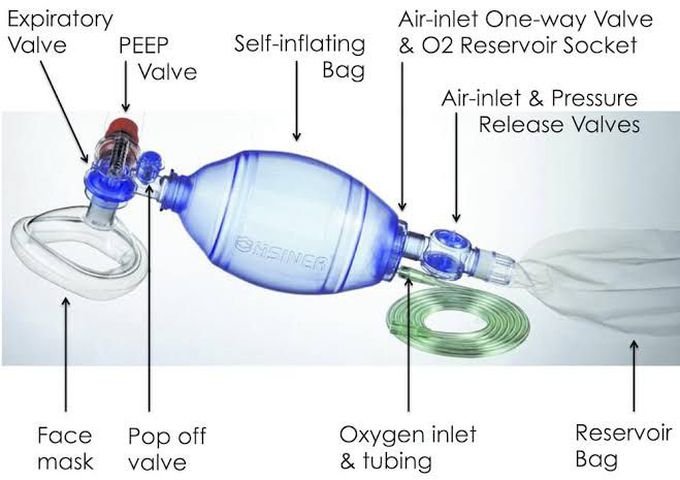


The bag-valve-mask (BVM) ventilation
A simple illustrative guide to understand Bag-Valve-Mask (BVM) Ventilation **OVERVIEW** * Bag-Valve-Mask (BVM) apparatus are also known as manual resuscitators and as self-inflating resuscitation systems-examples include LaerdalTM, AmbuTM, HsinerTM, MayoTM, and Air VivaTM **USES** * administration of high flow O2 * provision of PEEP (positive end-expiratory pressure) * provision of controlled ventilation * provision of augmentation of spontaneous ventilation **METHOD OF INSERTION AND/OR USE** * High flow oxygen (e.g. 15 L/min) is attached to the system and it is attached to a mask or tube * appropriate mask size * place over mouth and nose * tight fit * open airway using two-handed thumbs down technique (with an assistant bagging) in preference to the less effective one-handed C-E grip to ensure airway patency * the bag is used to deliver oxygen to a spontaneously breathing patient or the bag compressed to manually ventilate them via a mask or tube (an assistant can provide ventilations) Remember JAWS for the two-handed two-thumbs down two person technique: * Jaw thrust * Airways (oral/nasal) * Work together * Slow, small squeeze — 6-7 cc/kg, over 1-2 seconds, at <12/min, using low pressure. **COMPLICATIONS** * easy to hyperventilate patients and limited ability to gauge tidal volumes * poor seal is common if one-handed CE grip is used * gastric distension * aspiration * claustrophobia * exhaled secretions and moisture can result in exhalation valve dysfunction and increased resistance to expiration * risk of barotrauma if pop off valve close as unable to feel lung compliance with self-inflating bags * equipment failure (e.g. due to incorrect assembly) sterilization :Some **Ambu bags** can be **sterilized** in an autoclave at 134° C or 272° F. Otherwise, it must be **sterilized** through the use of the recommended disinfectant solution. Glutaraldehyde 2% is an appropriately high-level disinfectant; the **bag** must be immersed in the solution for at least 20 minutes

